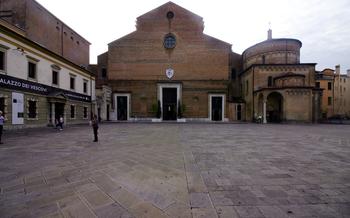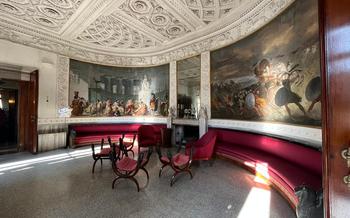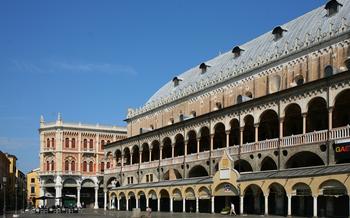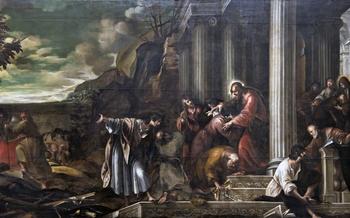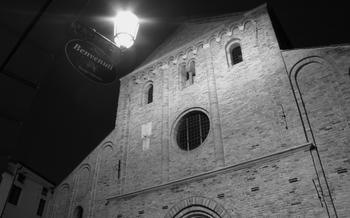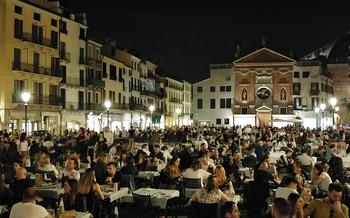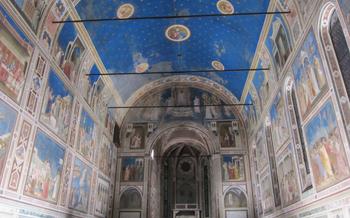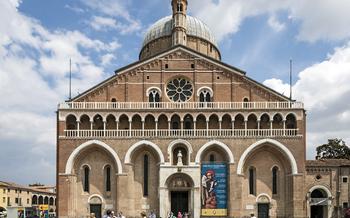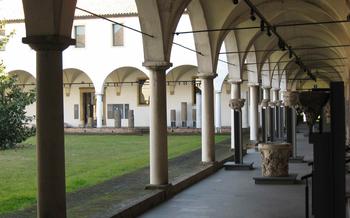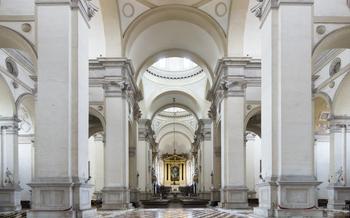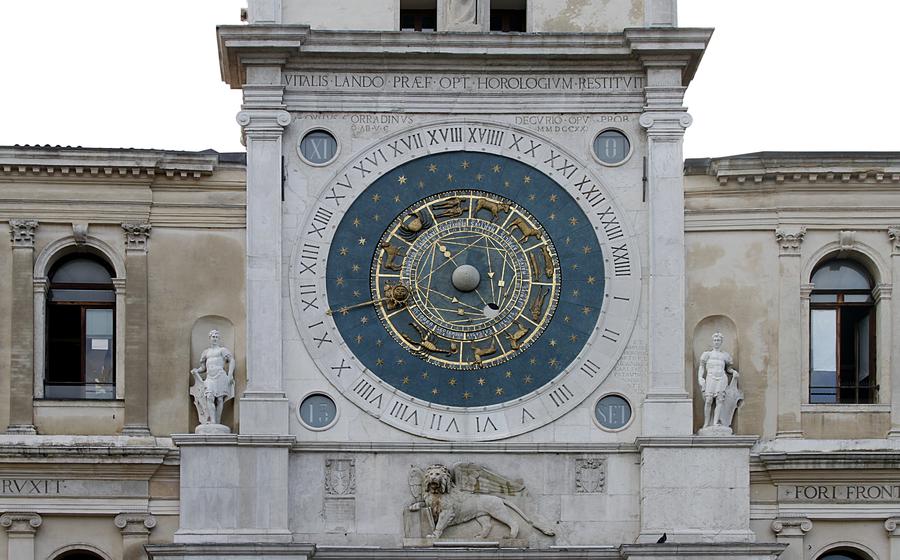
Torre dell'Orologio
- Architecture and Design
- Clock Mechanism
- Giants of the Clock Tower
- Loggia della Gran Guardia
- Duomo of Padua
- Cappella degli Scrovegni
- Palazzo Bo
- Caffè Pedrocchi
- Palazzo della Ragione
- Osservatorio Astronomico
- Prato della Valle
- Basilica of Sant'Antonio
- Insider Tips
Architecture and Design
The Torre dell'Orologio proudly stands as a remarkable embodiment of Gothic architecture, soaring majestically over the Piazza dei Signori, the very heart of Padua. Constructed entirely of red Verona marble, this magnificent tower exhibits a harmonious blend of elegance and strength. Its sturdy walls, adorned with intricate carvings and embellished with pointed arches and pinnacles, showcase the exceptional craftsmanship and attention to detail that characterized Gothic design. At 53 meters in height, the Torre dell'Orologio dominates the city skyline, serving as a testament to the artistry and architectural prowess of the era.
Clock Mechanism
The clock mechanism of the Torre dell'Orologio is a masterpiece of medieval engineering and astronomy. Constructed in 1344 by Jacopo Dondi, also known as Jacopo de' Dondi, it is one of the oldest astronomical clocks still in operation. Dondi, a renowned physician and astronomer, was commissioned by the Signoria of Padua to create a clock that would accurately track time and display astronomical phenomena.
The clock is composed of a series of interlocking gears and wheels that drive a series of dials and indicators. The main dial, located on the exterior of the tower, displays the hours, minutes, and seconds. It also features a 24-hour dial with movable hands that indicate the position of the sun and moon in the sky. The clock's astrolabe, a device used to calculate the positions of stars and planets, is located on the interior of the tower and is still used by astronomers today.
Dondi's clock was not only an accurate timepiece, but also a symbol of Padua's scientific and cultural prowess. It was a marvel of its time and remains a testament to the ingenuity and craftsmanship of medieval artisans.
Giants of the Clock Tower
The Torre dell'Orologio is crowned by two imposing bronze figures known as the Giants of the Clock Tower. These colossal statues, each standing over 6 meters tall, have become iconic symbols of Padua. Cast in 1344 by Jacopo and Giovanni Dondi dell'Orologio, the same masterminds behind the astronomical clock, these figures represent two opposing forces: on one side, the shepherd, symbolizing the common man and the passage of time, and on the other, the knight, the embodiment of power and nobility.
The shepherd, with his simple clothing and humble demeanor, strikes the bell every hour, marking the relentless march of time that affects all, regardless of status or wealth. In contrast, the knight, clad in intricate armor and wielding a mace, stands guard over the city, representing the eternal struggle against time's encroachment. Together, these two figures serve as a poignant reminder of the duality of human existence: the constant battle between the inexorable forces of time and the indomitable spirit of mankind.
Loggia della Gran Guardia
The Loggia della Gran Guardia, located on the southern side of the Piazza dei Signori, complements the aesthetic appeal of the Torre dell'Orologio. This stunning loggia is an architectural masterpiece, built in the 15th century under the guidance of Venetian architects. Its design echoes the flamboyant Gothic style prevalent during that era and features an elegant series of rounded arches supported by slender columns.
In the past, the Loggia della Gran Guardia served as a venue for judicial proceedings and ceremonies. It was also used as a meeting place for city officials and an assembly point for soldiers. Today, the loggia is open to the public and often serves as a venue for exhibitions and cultural events. Visitors can admire its intricate carvings and soak in the bustling atmosphere of the square.
Duomo of Padua
The Duomo of Padua, also known as the and a testament to the city's rich history. Construction of the cathedral began in the 12th century, and it was consecrated in 1180. Over the centuries, it has undergone several renovations and additions, resulting in a harmonious blend of architectural styles.
The Duomo's exterior is characterized by its intricate stone carvings, flying buttresses, and towering spires. The façade is adorned with a series of sculptures depicting biblical scenes and figures, while the bell tower, standing at 82 meters tall, offers breathtaking views of the city.
Inside, the Duomo boasts a nave and two aisles separated by massive columns. The vaulted ceiling is decorated with frescoes depicting scenes from the life of Christ and the Virgin Mary. The cathedral houses several chapels, each with its own unique architectural features and works of art, including the Cappella del Santissimo Sacramento with its elaborate altarpiece and the Cappella della Madonna della Salute, which contains a miraculous statue of the Virgin Mary.
One of the most notable features of the Duomo of Padua is the Baptistery of San Giovanni Battista, located to the south of the cathedral. Built in the 13th century, the Baptistery is a masterpiece of Gothic architecture and features a magnificent portal decorated with intricate carvings. The interior of the Baptistery is adorned with frescoes by Giusto de' Menabuoi, depicting scenes from the life of John the Baptist.
Cappella degli Scrovegni
The Cappella degli Scrovegni is undoubtedly one of Padua's most renowned attractions. Built in the early 14th century by the wealthy banker Enrico Scrovegni, it houses a breathtaking cycle of frescoes by the Italian master Giotto. The chapel's walls and ceiling teem with intricate and vivid scenes from the life of Christ and the Virgin Mary, demonstrating Giotto's genius in capturing human emotion and perspective.
Giotto's masterpieces in the Scrovegni Chapel revolutionized the art of painting. His use of chiaroscuro, or light and shadow, to model forms and create depth was unprecedented in his time. Moreover, Giotto's figures exhibit a naturalism and emotional expressiveness that set a new standard for religious art. The chapel's frescoes have been meticulously restored, allowing visitors to appreciate the brilliance of Giotto's artistry in its full glory.
Beyond its artistic significance, the Scrovegni Chapel holds immense historical and religious value. It was commissioned by Enrico Scrovegni as a place of worship and a testament to his faith. The chapel's decoration reflects the profound spiritual beliefs of the period and provides a glimpse into the religious mindset of medieval Padua.
Palazzo Bo
The Palazzo Bo is one of the oldest and most prestigious university buildings in the world. It has been the seat of the University of Padua since 1493 and is a symbol of the city's rich academic tradition.
The Palazzo Bo was built in the 15th century and has undergone several renovations and expansions over the years. It is a complex of buildings with different architectural styles, from Gothic to Renaissance. The main facade is characterized by a large courtyard with a portico and a tower.
The Palazzo Bo is the seat of the University Rector's office and several departments and faculties. It is also home to the University Library, which houses over one million books and manuscripts.
The Palazzo Bo is a popular tourist destination and is open to the public. Visitors can admire the beautiful architecture, visit the University Library, and learn about the history of the University of Padua.
Caffè Pedrocchi
In the heart of Padua, on the elegant Piazza Garibaldi, stands Caffè Pedrocchi, an iconic institution steeped in history, art, and literature. Founded in 1831 by Antonio Pedrocchi, it quickly became a popular gathering place for students, intellectuals, and artists, and would soon be considered a symbol of the Italian Risorgimento movement.
The cafe, with its lavish interiors adorned with frescoes, mirrors, and chandeliers, exudes an atmosphere of grandeur that belies its humble origins. It is divided into several rooms, the most famous of which is the "Sala Verde," known for its green wallpaper and frescoed ceiling. Other highlights include the "Sala Rossa," with its red velvet upholstery, and the "Caffè delle Donne," reserved exclusively for women at the time of its opening, breaking with the social norms of the period.
Caffè Pedrocchi has played a prominent role in the cultural and literary scene of Padua. It was frequented by renowned writers such as Stendhal, Lord Byron, and Ernest Hemingway, who found inspiration and companionship within its walls. Its influence extended beyond the cafe's physical space, contributing to the city's reputation as a hub of learning and artistic expression.
Palazzo della Ragione
The Palazzo della Ragione is one of Padua's most iconic landmarks, renowned for its unique Great Hall, also known as the Salone. This vast hall, measuring an impressive 87 meters in length and 27 meters in width, is supported by 78 massive stone columns, creating a breathtaking and awe-inspiring space. The walls are adorned with centuries-old frescoes, depicting scenes from history, mythology, and everyday life, offering a glimpse into the city's rich past.
One of the most notable features of the Palazzo della Ragione is the Astronomical Clock, built by Giovanni Dondi dell'Orologio in the 14th century. This mechanical marvel is a testament to the ingenuity and craftsmanship of its creator, accurately displaying the time, phases of the moon, and the positions of the planets. The clock's intricate mechanism and beautiful design make it a true masterpiece of medieval engineering.
Osservatorio Astronomico
The Osservatorio Astronomico di Padova is a historic astronomical observatory located in the heart of Padua. Built in the early 18th century, it is one of the oldest observatories in the world and is renowned for its groundbreaking contributions to the field of astronomy.
Over the centuries, the Osservatorio has been used by renowned astronomers to make important discoveries, including the first accurate measurement of the speed of light by James Bradley in the 18th century. It is also closely associated with Galileo Galilei, who used the observatory to make his revolutionary observations of the moons of Jupiter in the 17th century.
Today, the Osservatorio Astronomico is a vibrant center for astronomy research and education. It houses a collection of historic telescopes and scientific instruments, some of which date back to the 18th century. Visitors can explore the observatory's exhibits and take part in guided tours, which offer an immersive journey into the history of astronomy and the important discoveries made within these walls.
Don't miss the chance to climb the tower of the observatory (Torre del Sole) for a breathtaking panoramic view of Padua and the surrounding countryside. It is an experience that will transport you back in time, connecting you with the great minds of the past who gazed at the stars from this very spot.
Prato della Valle
Largest Square in Padua: The Prato della Valle is undoubtedly one of Padua's most impressive landmarks. Built on the site of a Roman amphitheater, it holds the record for being the largest square in Padua and one of the largest in Italy. Its immense expanse, covering over 90,000 square meters, is particularly striking when viewed from above.
Statues and Monuments: The square is adorned with a circular canal, crossed by four bridges, that surrounds an island featuring a large green area with walking paths and flower beds. The perimeter of the Prato della Valle is lined with 78 statues of illustrious figures from Padua's history, art, science, and literature. These statues, arranged in pairs facing each other, create a harmonious and visually captivating ensemble.
Island of Memmia: At the heart of the Prato della Valle lies the Island of Memmia, accessible via four bridges. This verdant oasis offers a serene retreat from the bustling city, inviting visitors to stroll along its shaded paths, relax on benches amidst the greenery, or admire the elegant fountain that graces its center.
A Place for Leisure and Events: The Prato della Valle serves as a popular gathering place for locals and tourists alike. Its ample green spaces make it an ideal spot for leisurely walks, picnics, and outdoor activities. The square also hosts various cultural events, concerts, and exhibitions throughout the year, transforming it into a vibrant hub of entertainment.
Basilica of Sant'Antonio
The Basilica of Sant'Antonio is one of Padua's most significant religious buildings. It was built in the 13th century to house the relics of Saint Anthony of Padua, one of the most revered saints in the Catholic Church. The basilica is a masterpiece of Gothic architecture, with its soaring spires and intricate carvings. The interior of the church is equally impressive, with its vast nave, stained glass windows, and numerous works of art. The basilica is a major pilgrimage site, and millions of visitors from all over the world come to visit the tomb of Saint Anthony each year.
The basilica is also home to several important works of art, including the equestrian statue of Gattamelata by Donatello, which is considered one of the masterpieces of Renaissance sculpture. The basilica's treasury also contains a number of valuable relics, including the skull of Saint Anthony.
If you are interested in history, art, or religion, the Basilica of Sant'Antonio is a must-see attraction in Padua. It is a truly awe-inspiring building and a testament to the power of faith.
Insider Tips
The best time to visit the Torre dell’Orologio is undoubtedly in the late afternoon, when the setting sun casts a warm, golden glow over the tower and the surrounding buildings. This is the perfect time to capture some truly memorable photos of this iconic landmark. To get the best shot, position yourself in front of the tower and use a wide-angle lens to capture its full grandeur. Be sure to include the Duomo and the Palazzo della Ragione in your frame for a truly stunning composition.
If you're visiting during the summer months, the tower is open until 11 pm, giving you plenty of time to enjoy the views and take some night-time photos. The illuminated tower is a sight to behold, and it's a great way to end a day of exploring Padua.
